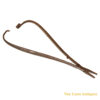Description
The heliostat is designed to reflect a beam of sunlight in a fixed direction, and uses a clockwork driven mirror to counteract the apparent motion of the sun through the sky. The resulting steady beam of sunlight would often be projected into a laboratory for experiments requiring intense light, physical optics studies, microscopy, analysis of the solar spectrum, etc.
This example has an octangular mirror, a clockwork mechanism, and tri-leg base with leveling screws. The inscription on the clock housing reads “J. T. Silbermann Invteur / Fait par J. Duboscq à Paris”.
Jean Thiebaut Silbermann (1806-1865), a physics demonstrator at the Conservatoire des Arts et Métiers in Paris, designed the form in 1843. J. B. F. Soleil made the first examples. Jules Duboscq, Soleil’s son-in-law and successor, was still offering these instruments in 1880s. He made them in collaboration with the Parisian clockmaker Jean Paul Garnier (1801-1869).
Height: 37 cm.
Diameter: 25 cm
Find out more on www.vanleestantiques.com
Ask the Dealer
Dealer information
 Van Leest Antiques
Van Leest Antiques
Van Leest Antiques
Van Leest Antiques, based in Utrecht in the Netherlands, specialises in antique scientific and medical instruments. Their collection covers mainly scientific and medical antique instruments: barometers, globes and planataria, nautical instruments, anatomical models, and pharmacy items. Toon Van Leest travels regularly in Europe and visits trade fairs, auctions, and antique dealers to collect stock and to find pieces to fulfil his clients' unusual requests.
As well as being an avid antique collector and dealer, Toon Van Leest is also a dentist. He believes that antiques are a stable investment, not reliant on trends or fashion, and have truly lasting value. Above all, he says, antiques are timeless and never lose their beauty.
Other items See all
-

-

-
 Anonymous Chest microscope, first half 19th century Price on application
Anonymous Chest microscope, first half 19th century Price on application -









